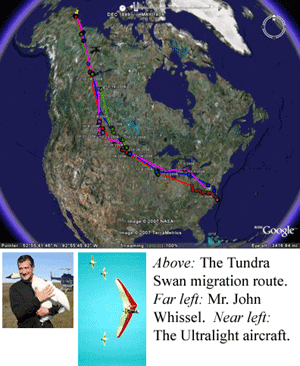 | In this Section: | |  | In the Spotlight |  | News |  |
List of "In the Spotlight" Features
Flying With Swans

|
Have you ever wondered what it would be like to be a bird? Well, scientists at the Swan Research Program (SRP) of Environmental Studies at Airlie think about it all the time. Much of their research takes them into the air, studying the migration of swans, geese and cranes, and sometimes even acting as surrogate parents to young birds in order to teach them how to migrate.
One of the main projects going on at SRP today is the Tundra Swan Migration Project. During the summer of 2006, 59 Tundra Swans were neckbanded on the North Slope of Alaska in ConocoPhillips Kuparuk Oilfields. Tundra Swans find a partner when they are 2-3 years old and then they migrate with their partners. Eight of the banded birds were fitted with satellite transmitters and their partners each carry a VHF radio transmitter. The VHF transmitter are working fine, however, only one satellite transmitter is still sending a signal.
This population of Tundra Swans from the North Slope of Alaska flies about 4,000 miles right across the continent each way, along the same general route each year. However, they do not always stop to rest and fuel up in the same exact locations (staging areas) along their migration from the Atlantic Coast to their Arctic breeding grounds. Swans (as well as geese and cranes) learn their migration route during their first year of life. Swan parents migrate from their breeding grounds to their wintering grounds and back with the young swans they hatched that summer. Once they return to their breeding grounds, the parents send their young away, and nest again. The brother and sister young swans will remain together until they are old enough to find their own partners and breed. Each winter the young will repeat the migration route they learned in their first year of life, eventually teaching this migration route to their offspring.
The Swan Research Program is tracking one breeding population of Tundra Swans over several years to try to learn about how this migration is passed from one generation to the next. The migration routes the swans take, and the staging areas they use can vary a little each year. Mr. John Whissel and his partners at SRP seek to learn how and why swans make small changes to their migration route year after year.
Tundra Swan populations that once spent the winter in the Chesapeake Bay in large numbers have changed destination and are mostly wintering along the coastal plain of North Carolina instead. Signals of Spring students can join Mr. Whissel in questioning why the swans have made this change. Are there environmental conditions that have caused the swans to move toward the North Carolina coast? Is this a result of changes to the Chesapeake Bay, North Carolina's coastal plain, their Arctic breeding territories or some combination?
SRP hopes that some of what they discover about how swans learn a migration route will help reintroduce an eastern migration of a different type of swan, Trumpeter Swans. Trumpeter Swans are the largest flying bird in North America. These beautiful swans once bred in wetlands across the continent. Like Tundra Swans, many Trumpeter Swans wintered along the United States' East Coast. By 1900, the Trumpeter Swan population was close to extinction, and the eastern migration was completely lost because of hunting and habitat loss. Conservation efforts, education, research, and laws that protect Trumpeter Swans have all helped the species make a comeback. However, because of the way in which swans learn a migration route, the restoration of an East Coast wintering flock is unlikely without some help.
The Swan Research Program of Environmental Studies at Airlie (ESA) and their partners at Operation Migration developed the Ultralight Technique in an effort to restore lost migration routes of swans, geese, and cranes. Pilots of the ultralight aircraft train Trumpeter Swans to follow their small planes during their first few months of life. The birds follow the pilots, who have become the birds' surrogate parents, from their northern breeding ground to carefully selected wintering grounds. The birds are then released and repeat the route they learned each year. Once these birds nest and have their own cygnets, they will teach their offspring to migrate. The birds are able to do this without the help of the ultralight pilots, which means that the lost migration route is restored.
Stayed tuned for updates about the Tundra Swans' spring migration and the exciting research happening at The Swan Research Center in Virginia!
|
